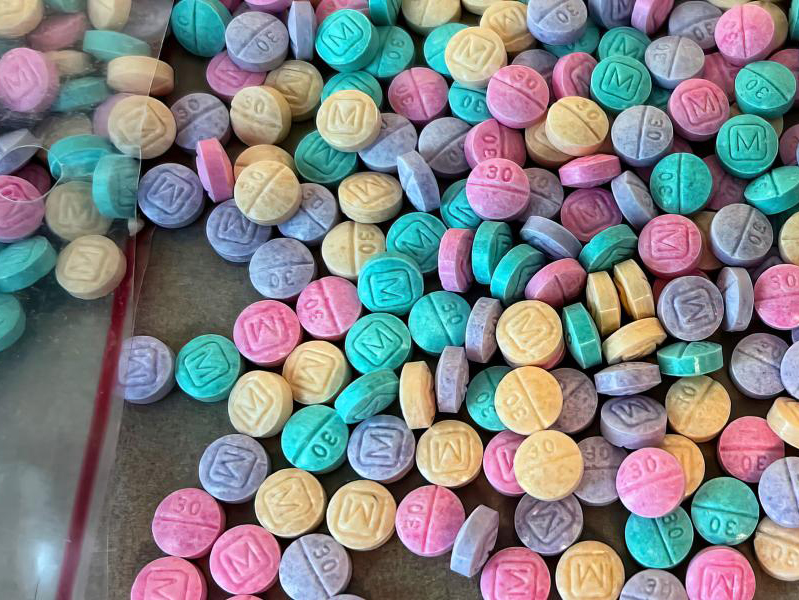HEALTH ADVISORY: Multi-Colored or Rainbow Fentanyl

Summary

Photo courtesy of US DEA
Colorful versions of fentanyl (“multi-colored” or “rainbow” fentanyl) have recently appeared in the illicit drug market. Law enforcement agencies, including the United States Drug Enforcement Administration (DEA), have issued alerts after recent suspected overdoses and deaths involving fentanyl in children in Hays County, Texas.
The DEA has seized rainbow-colored fentanyl pills in at least 18 states. According to the DEA, the rainbow colors could lead children to mistake them for candy and make them more appealing to young people. It takes much less for someone, including children, to overdose or die. Even a tiny amount (around two milligrams) of fentanyl can kill.
Background
Fentanyl is a synthetic opioid approved for treating severe pain with a prescription. Fentanyl is 50 times stronger than heroin and 100 times stronger than morphine, making it effective in pain relief but also more likely to cause overdose if misused. Fentanyl-related overdose and death are frequently linked with illegally made and sold fentanyl that are often mixed with heroin and/or cocaine. According to the Centers for Disease Control and Prevention, in 2021 there were an estimated 100,306 drug overdose deaths in the U.S., with 66 percent of those deaths related to synthetic opioids like fentanyl.1 In Texas, the incidence of fentanyl-related deaths has climbed sharply, with 214 deaths attributed to fentanyl in 2018 and 1,672 fentanyl-related deaths in 2021 according to provisional data.
Recommendations
General Public
- Never use illicit or other drugs purchased on the street or of unknown origin.
- Adults are encouraged to talk to children and teens about the dangers of ingesting unknown substances.
- Keep all prescription medications and other drugs out of the reach of children.
- Contact 9-1-1 if there is an emergency.
- Contact your healthcare provider or the Texas Poison Center Network at 1-800-222-1222 if you are experiencing any adverse health effects or have questions or concerns about exposure to fentanyl or opioid overdose.
- Individuals and organizations can access naloxone (opioid reversal agent) through the state’s distribution program: morenarcanplease.com.
First Responders and Medical Providers
- If symptoms are compatible, consider opioid overdose even in children or patients without a known history of opioid use. Symptoms can include slowed breathing, dizziness or confusion, unresponsiveness, and pale, blue, or cold skin.
- Use naloxone (opioid reversal agent) per protocol when opioid overdose is suspected with awareness that more and prolonged administrations may be required to fully reverse an overdose.
- First responders should practice standard safety precautions, including use of appropriate personal protective equipment. For details, visit the Fentanyl: Emergency Responders at Risk | Substance Use | CDC webpage.
- Educate and counsel patients about illicit drug supply and risks for overdose and exposure to highly potent opioids such as illicitly manufactured fentanyl.
Overdose Reporting
Texas Health and Safety Code §161.042 requires health care providers or any person treating an overdose of a controlled substance listed in Penalty Group 1 to notify DSHS within 24 hours. For more information on where and how to report an overdose, visit the DSHS Reporting Controlled Substance Overdoses webpage.
Contact Information
For questions about this health alert please contact:
DSHS Environmental Surveillance and Toxicology Branch
512-776-7268
epitox@dshs.texas.gov
Additional Resources
- Texas Poison Network Center
- Call 1-800-222-1222
- poisoncontrol.org
- Texas Targeted Opioid Response (TTOR): txopioidresponse.org
- Resources for behavioral health services: mentalhealthtx.org
- Resources for continuing education related to substance use for health professionals: DSHS Substance Use Action Plan
References
1 Centers for Disease Control and Prevention. Drug Overdose Deaths in the U.S. Top 100,000 Annually. November 17, 2021.
